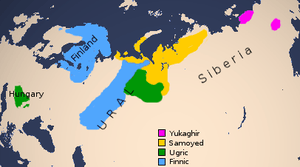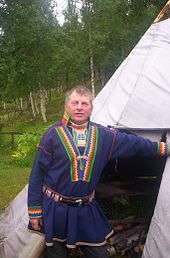Uralic peoples
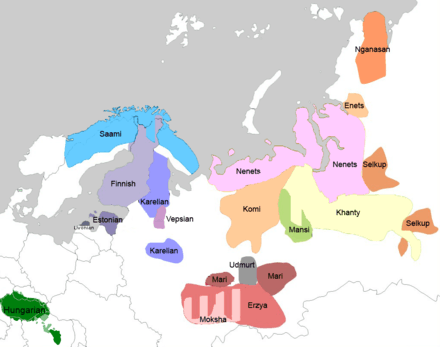 Distribution of Uralic peoples | |
| Total population | |
|---|---|
| ~26,554,700 | |
| Regions with significant populations | |
| Russia, Hungary, Finland, Estonia, Scandinavia | |
| Languages | |
| Uralic languages | |
| Religion | |
| various Christian faiths, Shamanism, Uralic Neopaganism |
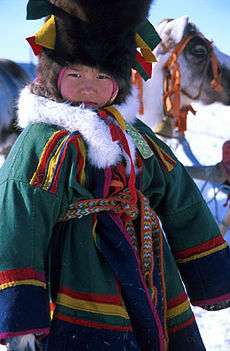
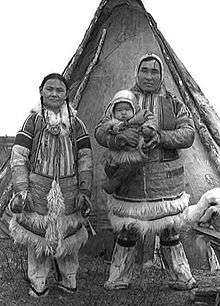

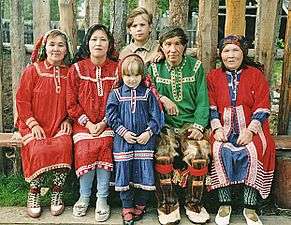
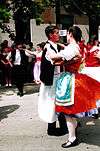

The Uralic peoples or Uralic speaking peoples are the peoples speaking Uralic languages, divided into two large groups: Finno-Ugric peoples and Samoyedic peoples. The Samoyeds consists of Northern Samoyed: Nenets, Enets and Nganasan, and Southern Samoyed: Selkup and now extinct Sayan Samoyed. The Finno-Ugric group contains two branches: Ugric including Ob-Ugric peoples i.e. the Mansi and Khanty and the Hungarians. The Finnic group has four sub-divisions: The Sami, The Baltic Finns: Finns proper, Karelians, Ingrians, Vepsians, Votians, Estonians and Livonians, and the Volga Finns: the Mordvins subdivided into Moksha and Erza and the Mari, and the Permians.[1]
History
According to the recent understanding of Uralic studies, the establishment of Proto-Uralic peoples goes back to the Stone Age in the 5th millennium BC. Then, Proto-Ural divided into Proto-Samoyed and Proto-Finno-Ugric. The latter is the carrier of Pit–Comb Ware culture.
Life
Samoyed, Khanty and Mansi have bred reindeer around the tundra between the Ob River and the Yenisei and made it available as various tools of life, from food sources to the means of transportation. Komi has been engaged in agriculture and reindeer breeding, and settled in the forest. Sami, via contact with Scandinavian agrarian society from ancient times, has been conducting high-intensive animal husbandry by trade. Ancient Hungarians were equestrian nomads. In Finland, Estonia, and Hungary, they worked as a remarkable bearer of modern states based on agriculture and industry.
Genetics
The genetics characterizing Uralic peoples is haplogroup N1c (Y-DNA). 97% of Nenets, 92% of Nganasans,[2] 63% of Finns,[3] 47% of saami[4] and 41% of Estonians[5] belong to this haplogroup. Haplogroup N originated in the northern part of China in 20,000 -25,000 years BP[6] and spread to the north Eurasia, through Siberia to Northern Europe. A subgroup N1c1 is frequently seen in Finno-Ugric people, N1c2 in Samoyedic peoples. In addition, haplogroup Z (mtDNA), found with low frequency in Saami, Finns and Siberia, is related to Uralic peoples’ migration.
Urheimat
The Urheimat, the location of the most ancient habitat of the Uralic peoples, is considered by various theories. Gy. Laszlo has placed the origin in the forest zone between the Oka river and Central Poland. The writings of E. N. Setala and M. Zsirai place the original homeland in the Middle of the Volga and Kama region. According to E.Itkonen, the area extended to the Baltic sea. P. Hajdu has suggested the Uralic homeland being in Western and North-western Siberia.[7]
In recent genetic analysis of ancient human bones excavated from the remains of Liao civilization (Xinglongwa culture, Hongshan culture, etc.), haplogroup N1 (Y-DNA) was found with high frequency of 71%, including old paragroups of N1.[8] So, a new possibility arose that the Urheimat of Uralic peoples (and perhaps also Yukaghir people) is the Liao river region. The oldest Pit–Comb Ceramic, related to Finno-Ugric peoples, is found in Liao civilization. This is also consistent with the works of Vladimir Napolskikh, who places the ultimate homeland of the Uralic peoples (and other populations with high frequencies of the N1 Y-DNA haplogroup) in the Northeastern Asia, based on his studies of the origins of so-called "earth-diver" myth.[9] According to Prof. Napolskikh, the split between Finno-Ugric and Samoyedic branches might have occurred somewhere in the area between the Ob River and the Irtysh River, following an earlier split between Proto-Uralic and Proto-Yukaghir somewhere in Eastern Siberia.[10]
List of Uralic peoples
- Finno-Ugric peoples
- Finnic peoples
- Baltic Finns (not to be confused with Baltic peoples)
- Sami
- Volga Finns
- Permians
- Ugric peoples
- Finnic peoples
- Samoyedic peoples
See also
References and notes
- ↑ The Cambridge History of Early Inner Asia, p. 230
- ↑ Tambets, Kristiina et al. 2004, The Western and Eastern Roots of the Saami—the Story of Genetic “Outliers” Told by Mitochondrial DNA and Y Chromosomes
- ↑ Rosser ZH, Zerjal T, Hurles ME, Adojaan M, Alavantic D, Amorim A, Amos W, Armenteros M, Arroyo E, Barbujani G, Beckman G, Beckman L, Bertranpetit J, Bosch E, Bradley DG, Brede G, Cooper G, Côrte-Real H. B., De Knijff P, Decorte R, Dubrova YE, Evgrafov O, Gilissen A, Glisic S, Gölge M, Hill EW, Jeziorowska A, Kalaydjieva L, Kayser M et al. (2000). "Y-Chromosomal Diversity in Europe is Clinal and Influenced Primarily by Geography, Rather than by Language". The American Journal of Human Genetics 67 (6): 1526–1543. doi:10.1086/316890. PMC 1287948. PMID 11078479. Vancouver style error (help)
- ↑ Tambets K, Rootsi S, Kivisild T, Help H, Serk P, Loogväli EL et al. (2004). "The western and eastern roots of the Saami--the story of genetic "outliers" told by mitochondrial DNA and Y chromosomes". Am. J. Hum. Genet. 74 (4): 661–82. doi:10.1086/383203. PMC 1181943. PMID 15024688. Vancouver style error (help)
- ↑ Rosser ZH, Zerjal T, Hurles ME, Adojaan M, Alavantic D, Amorim A, Amos W, Armenteros M, Arroyo E, Barbujani G, Beckman G, Beckman L, Bertranpetit J, Bosch E, Bradley DG, Brede G, Cooper G, Côrte-Real H. B., De Knijff P, Decorte R, Dubrova YE, Evgrafov O, Gilissen A, Glisic S, Gölge M, Hill EW, Jeziorowska A, Kalaydjieva L, Kayser M et al. (2000). "Y-Chromosomal Diversity in Europe is Clinal and Influenced Primarily by Geography, Rather than by Language". The American Journal of Human Genetics 67 (6): 1526–1543. doi:10.1086/316890. PMC 1287948. PMID 11078479. Vancouver style error (help)
- ↑ Shi H, Qi X, Zhong H, Peng Y, Zhang X, et al. (2013) Genetic Evidence of an East Asian Origin and Paleolithic Northward Migration of Y-chromosome Haplogroup N. PLoS ONE 8(6): e66102. doi:10.1371/journal.pone.0066102
- ↑ The Cambridge History of Early Inner Asia, p. 231
- ↑ Yinqiu Cui, Hongjie Li, Chao Ning, Ye Zhang, Lu Chen, Xin Zhao, Erika Hagelberg and Hui Zhou (2013)"Y Chromosome analysis of prehistoric human populations in the West Liao River Valley, Northeast China. " BMC 13:216
- ↑ Napolskikh V. V. (Izhevsk, Russia). Earth-Diver Myth (А812) in northern Eurasia and North America: twenty years later.
- ↑ Предыстория народов уральской языковой семьи (in Russian).
Sinor, Denis, ed. (1990). The Cambridge History of Early Inner Asia. Cambridge University Press. pp. 229–252. ISBN 0521243041.
